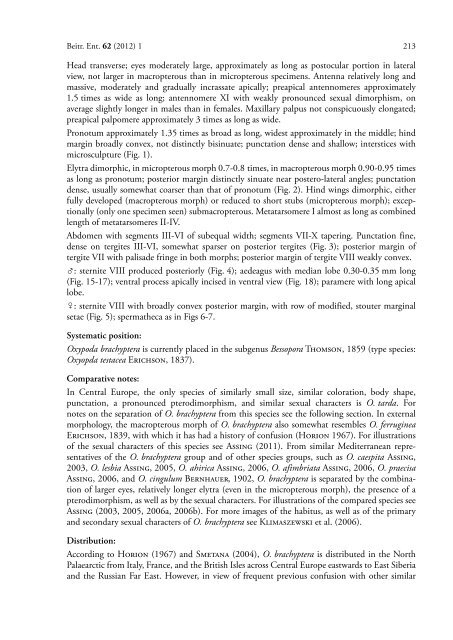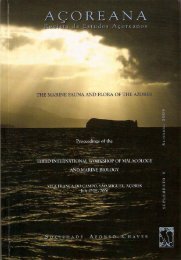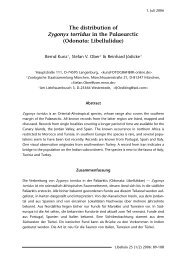On the taxonomy and natural history of Oxypoda brachyptera and O ...
On the taxonomy and natural history of Oxypoda brachyptera and O ...
On the taxonomy and natural history of Oxypoda brachyptera and O ...
You also want an ePaper? Increase the reach of your titles
YUMPU automatically turns print PDFs into web optimized ePapers that Google loves.
Beitr. Ent. 62 (2012) 1<br />
Head transverse; eyes moderately large, approximately as long as postocular portion in lateral<br />
view, not larger in macropterous than in micropterous specimens. Antenna relatively long <strong>and</strong><br />
massive, moderately <strong>and</strong> gradually incrassate apically; preapical antennomeres approximately<br />
1.5 times as wide as long; antennomere XI with weakly pronounced sexual dimorphism, on<br />
average slightly longer in males than in females. Maxillary palpus not conspicuously elongated;<br />
preapical palpomere approximately 3 times as long as wide.<br />
Pronotum approximately 1.35 times as broad as long, widest approximately in <strong>the</strong> middle; hind<br />
margin broadly convex, not distinctly bisinuate; punctation dense <strong>and</strong> shallow; interstices with<br />
microsculpture (Fig. 1).<br />
Elytra dimorphic, in micropterous morph 0.7-0.8 times, in macropterous morph 0.90-0.95 times<br />
as long as pronotum; posterior margin distinctly sinuate near postero-lateral angles; punctation<br />
dense, usually somewhat coarser than that <strong>of</strong> pronotum (Fig. 2). Hind wings dimorphic, ei<strong>the</strong>r<br />
fully developed (macropterous morph) or reduced to short stubs (micropterous morph); exceptionally<br />
(only one specimen seen) submacropterous. Metatarsomere I almost as long as combined<br />
length <strong>of</strong> metatarsomeres II-IV.<br />
Abdomen with segments III-VI <strong>of</strong> subequal width; segments VII-X tapering. Punctation fine,<br />
dense on tergites III-VI, somewhat sparser on posterior tergites (Fig. 3); posterior margin <strong>of</strong><br />
tergite VII with palisade fringe in both morphs; posterior margin <strong>of</strong> tergite VIII weakly convex.<br />
: sternite VIII produced posteriorly (Fig. 4); aedeagus with median lobe 0.30-0.35 mm long<br />
(Fig. 15-17); ventral process apically incised in ventral view (Fig. 18); paramere with long apical<br />
lobe.<br />
: sternite VIII with broadly convex posterior margin, with row <strong>of</strong> modified, stouter marginal<br />
setae (Fig. 5); sperma<strong>the</strong>ca as in Figs 6-7.<br />
Systematic position:<br />
<strong>Oxypoda</strong> <strong>brachyptera</strong> is currently placed in <strong>the</strong> subgenus Bessopora Thomson, 1859 (type species:<br />
Oxyopda testacea Erichson, 1837).<br />
Comparative notes:<br />
In Central Europe, <strong>the</strong> only species <strong>of</strong> similarly small size, similar coloration, body shape,<br />
punctation, a pronounced pterodimorphism, <strong>and</strong> similar sexual characters is O. tarda. For<br />
notes on <strong>the</strong> separation <strong>of</strong> O. <strong>brachyptera</strong> from this species see <strong>the</strong> following section. In external<br />
morphology, <strong>the</strong> macropterous morph <strong>of</strong> O. <strong>brachyptera</strong> also somewhat resembles O. ferruginea<br />
Erichson, 1839, with which it has had a <strong>history</strong> <strong>of</strong> confusion (Horion 1967). For illustrations<br />
<strong>of</strong> <strong>the</strong> sexual characters <strong>of</strong> this species see Assing (2011). From similar Mediterranean representatives<br />
<strong>of</strong> <strong>the</strong> O. <strong>brachyptera</strong> group <strong>and</strong> <strong>of</strong> o<strong>the</strong>r species groups, such as O. caespita Assing,<br />
2003, O. lesbia Assing, 2005, O. ahirica Assing, 2006, O. afimbriata Assing, 2006, O. praecisa<br />
Assing, 2006, <strong>and</strong> O. cingulum Bernhauer, 1902, O. <strong>brachyptera</strong> is separated by <strong>the</strong> combination<br />
<strong>of</strong> larger eyes, relatively longer elytra (even in <strong>the</strong> micropterous morph), <strong>the</strong> presence <strong>of</strong> a<br />
pterodimorphism, as well as by <strong>the</strong> sexual characters. For illustrations <strong>of</strong> <strong>the</strong> compared species see<br />
Assing (2003, 2005, 2006a, 2006b). For more images <strong>of</strong> <strong>the</strong> habitus, as well as <strong>of</strong> <strong>the</strong> primary<br />
<strong>and</strong> secondary sexual characters <strong>of</strong> O. <strong>brachyptera</strong> see Klimaszewski et al. (2006).<br />
Distribution:<br />
According to Horion (1967) <strong>and</strong> Smetana (2004), O. <strong>brachyptera</strong> is distributed in <strong>the</strong> North<br />
Palaearctic from Italy, France, <strong>and</strong> <strong>the</strong> British Isles across Central Europe eastwards to East Siberia<br />
<strong>and</strong> <strong>the</strong> Russian Far East. However, in view <strong>of</strong> frequent previous confusion with o<strong>the</strong>r similar<br />
213
















